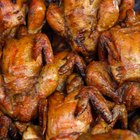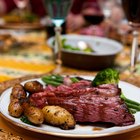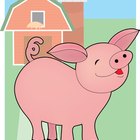
Roasting foods on a spit in front of a fire or over a bed of coals is one of the oldest and most basic cooking methods. It's still one of the best, because the rotating spit cooks your foods evenly and lets most of the fat drip away from your finished dish. If you're reluctant to give up countertop space to a single-purpose rotisserie oven, there are several other ways to enjoy rotisserie cooking.
Rotisserie On Your Grill
Your backyard grill provides a convenient location for rotisserie cooking. Most major grill manufacturers offer rotisserie attachments for their products, and there's a thriving aftermarket of third-party manufacturers building lower-cost or higher-quality alternatives. To use the rotisserie, mount the motor unit to your grill and build a bed of coals or preheat your burners, with heat on either side of the rotisserie but not directly underneath. Secure your food to the spit using the manufacturer's forks, and tying it with butcher's twine if necessary. Lock the spit into the rotisserie, close the lid, and roast your foods until done.
Open-Hearth Rotisserie
If your home contains a fireplace, you already have a hearth that can be used for truly old-school rotisserie. Many companies manufacture free-standing rotisserie units with manual or electric-powered cranks, and a few offer smaller self-contained units that can also be used in your oven. Build a large fire of hardwoods in your fireplace, and position the rotisserie unit in front of the fire once it's mostly burnt down to coals. Fix the meats or vegetables onto the spit, using the provided accessories or cotton butcher's twine. Roast your foods in front of the fire, turning the spit steadily, until they reach your desired degree of doneness.
Hanging On
In the south of France, pragmatic Provencal peasants manage a version of rotisserie cooking that requires less equipment, if slightly more work. Called cooking "a la ficelle," or on a string, it simply requires one or more hooks to be screwed into the mantle. Tie a trussed chicken or a leg of lamb to a length of cotton butcher's twine, and let it dangle in front of the coals in your fireplace. Spin the hanging bird or roast whenever you pass by, so it gently rotates and cooks the meat evenly. When it's done, simply snip the string and lower the meat to a serving platter.
A Few General Tips
Managing the fat and juices that drip from your rotisserie foods is a primary skill. On the grill, you should place a drip pan either underneath the rotisserie itself, or if there isn't enough room you can position it under the grill between the burners or mounds of coals. If you're rotisserie cooking in the fireplace, place a disposable foil pan under each item. You can use the drippings to baste your food as it cooks, for better flavor and color. To enjoy some seriously old-school cooking, prepare one or more of your side dishes in Dutch ovens on the hearth or in the coals. If you cook on the hearth regularly, be diligent about chimney-cleaning to reduce the risk of fatty buildup that can cause fires in the flue.
Related Articles
How to Cook on an Electric Rotisserie
How to Cook Prime Rib on an Electric ...

How to Barbecue Roast Beef

The Difference Between Grilled & ...
How to Cook With a Reverse Flow Smoker

Rotisserie Cooking Times

How to Cook a Roast Beef on a ...

How to Cook With a Gas Fireplace

How to Season Granite Grill Cooking ...

How to Smoke Pork on a Gas Grill

How to Light a Propane Barbecue Grill
How do I Cook a Prime Rib on an Open ...

How to Cook With the Sunbeam Rotisserie

How to Make Homemade Propane Pig Cookers

How to Cook Prime Rib Using an Oven ...

How to Use a Probe Cooking Thermometer

Difference Between Hibachi & Teriyaki

How to Grill a Ribeye on a Weber Q

How to Roast a Pork Blade Cut

How to Cook a Goose on the Grill
References
- On Food and Cooking: The Science and Lore of the Kitchen; Harold McGee
- The Wall Street Journal: Charred to Perfection, In Your Fireplace
Writer Bio
Fred Decker is a trained chef and prolific freelance writer. In previous careers, he sold insurance and mutual funds, and was a longtime retailer. He was educated at Memorial University of Newfoundland and the Northern Alberta Institute of Technology. His articles have appeared on numerous home and garden sites including GoneOutdoors, TheNest and eHow.
Photo Credits
Hemera Technologies/Photos.com/Getty Images